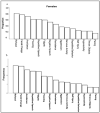Observable Symptoms of Anxiety in Individuals with Fragile X Syndrome: Parent and Caregiver Perspectives
- PMID: 36140827
- PMCID: PMC9498703
- DOI: 10.3390/genes13091660
Observable Symptoms of Anxiety in Individuals with Fragile X Syndrome: Parent and Caregiver Perspectives
Abstract
Caregiver reports, clinical observations, and diagnostic assessments indicate that most individuals with fragile X syndrome experience high levels of chronic anxiety. However, anxiety is a challenging endpoint for outcome measurement in FXS because most individuals cannot reliably report internal emotional or body states. A comprehensive survey of the presence, frequency, and duration of anxiety-related symptoms and questions to elicit open-ended responses was completed by caregivers of 456 individuals with FXS, ages 2-81 years (87 female, 369 male) and 24 female and 2 male FXS self-advocates ages 15-66 years. Caregivers reported classic behavioral indicators of anxiety, such as avoidance, irritability, motor agitation, and physiological symptoms, as well as behavioral features in FXS such as repetitive behavior, aggression, and self-injury. Self-advocate accounts largely paralleled caregiver data. Factor analyses yielded four factors: (1) increased irritability, aggression, and self-injury; (2) increased physical movement, nervous activity, and restlessness; (3) physical and physiological features of anxiety; and (4) internalizing and gastrointestinal symptoms. Caregivers are capable of observing and reporting behaviors that are valid indicators of anxious states that are usually reported in self-report standardized assessments. These results support the development of an anxiety measure for FXS that minimizes problems with rater inference.
Keywords: FMR1 gene; assessment; autism; intellectual disability.
Conflict of interest statement
The authors declare no conflict of interest.
Figures






